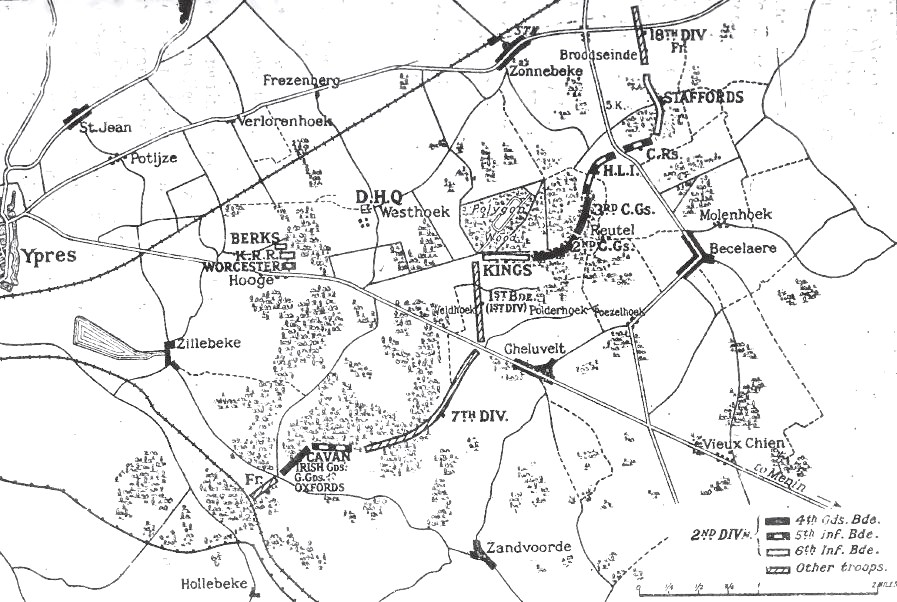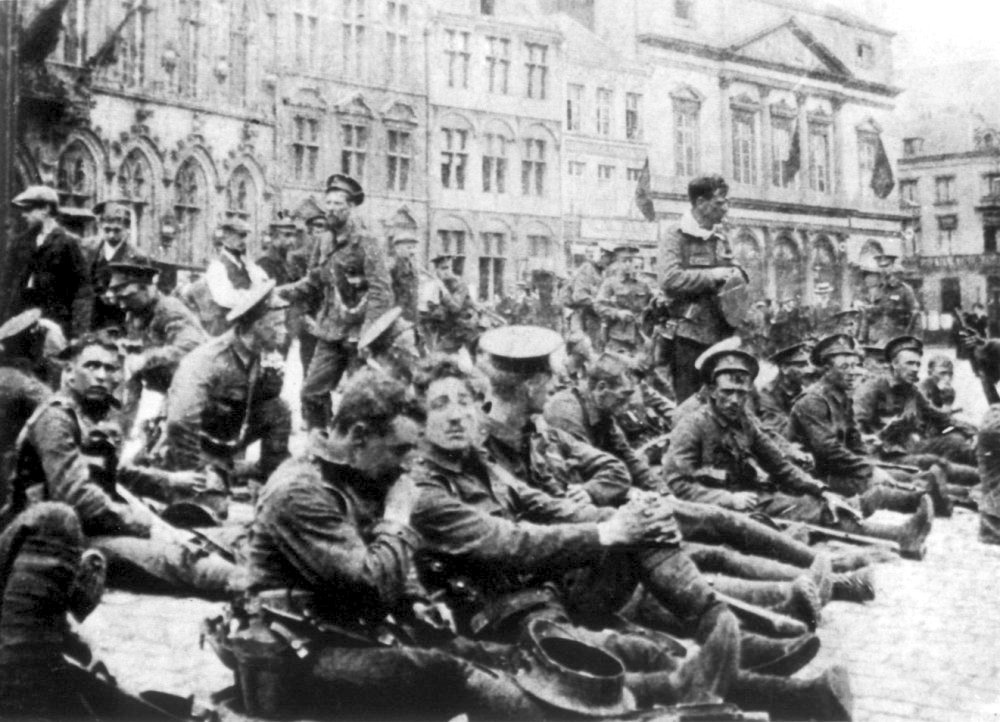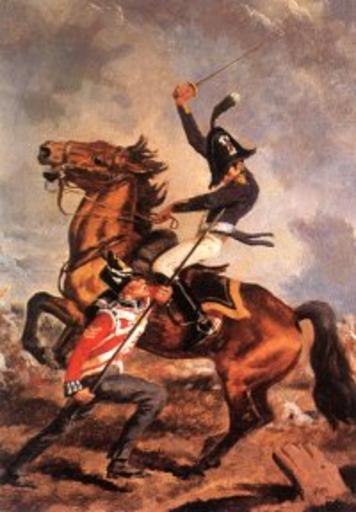|
3rd Guards Brigade (United Kingdom)
The 3rd Guards Brigade was an infantry brigade of the British Army in World War I. It was formed in France in August 1915 with two battalions already on the Continent and another two from England. It served with the Guards Division (United Kingdom), Guards Division on the Western Front (World War I), Western Front for the rest of the war. History Formation The 3rd Guards Brigade was formed at Lumbres, near Saint-Omer, St Omer, France on 15 August 1915. The 4th Battalion, Grenadier Guards and 1st Battalion, Welsh Guards joined on 18 and 20 August, respectively, from England and the 1st Battalion, Grenadier Guards and 2nd Battalion, Scots Guards joined on 5 and 8 August from 20th Infantry Brigade (United Kingdom), 20th Brigade, 7th Infantry Division (United Kingdom), 7th Division. The latter two battalions had been in Belgium and France from 5 October 1914 with the British Expeditionary Force (World War I), British Expeditionary Force. They served on the Western Front (World War ... [...More Info...] [...Related Items...] OR: [Wikipedia] [Google] [Baidu] |
Infantry
Infantry, or infantryman are a type of soldier who specialize in ground combat, typically fighting dismounted. Historically the term was used to describe foot soldiers, i.e. those who march and fight on foot. In modern usage, the term broadly encompasses a wide variety of subspecialties, including light infantry, irregular infantry, heavy infantry, mountain infantry, motorized infantry, mechanized infantry, Airborne forces, airborne infantry, Air assault, air assault infantry, and Marines, naval infantry. Other subtypes of infantry, such as line infantry and mounted infantry, were once commonplace but fell out of favor in the 1800s with the invention of more accurate and powerful weapons. Etymology and terminology In English, use of the term ''infantry'' began about the 1570s, describing soldiers who march and fight on foot. The word derives from Middle French , from older Italian (also Spanish) ''infanteria'' (foot soldiers too inexperienced for cavalry), from Latin '' ... [...More Info...] [...Related Items...] OR: [Wikipedia] [Google] [Baidu] |
Western Front (World War I)
The Western Front was one of the main Theatre (warfare), theatres of war during World War I. Following the outbreak of war in August 1914, the Imperial German Army, German Army opened the Western Front by German invasion of Belgium (1914), invading Luxembourg and Belgium, then gaining military control of important industrial regions in Third Republic of France, France. The German advance was halted with the First Battle of the Marne, Battle of the Marne. Following the Race to the Sea, both sides dug in along a meandering line of fortified trench warfare, trenches, stretching from the North Sea to the Swiss frontier with France, the position of which changed little except during early 1917 and again in 1918. Between 1915 and 1917 there were several offensives along this Front (military), front. The attacks employed massive artillery bombardments and massed infantry advances. Entrenchments, machine gun emplacements, barbed wire, and artillery repeatedly inflicted severe casualties ... [...More Info...] [...Related Items...] OR: [Wikipedia] [Google] [Baidu] |
Battle Of Givenchy
A battle is an occurrence of combat in warfare between opposing military units of any number or size. A war usually consists of multiple battles. In general, a battle is a military engagement that is well defined in duration, area, and force commitment. An engagement with only limited commitment between the forces and without decisive results is sometimes called a skirmish. The word "battle" can also be used infrequently to refer to an entire operational campaign, although this usage greatly diverges from its conventional or customary meaning. Generally, the word "battle" is used for such campaigns if referring to a protracted combat encounter in which either one or both of the combatants had the same methods, resources, and strategic objectives throughout the encounter. Some prominent examples of this would be the Battle of the Atlantic, Battle of Britain, and the Battle of France, all in World War II. Wars and military campaigns are guided by military strategy, whereas batt ... [...More Info...] [...Related Items...] OR: [Wikipedia] [Google] [Baidu] |
Battle Of Festubert
The Battle of Festubert (15–25 May 1915) was an attack by the British army in the Artois region of France on the western front during World War I. The offensive formed part of a series of attacks by the French Tenth Army and the British First Army in the Second Battle of Artois . After the failure of the breakthrough attempt by the First Army in the attack at Aubers Ridge (9 May 1915) tactics of a short hurricane bombardment and an infantry advance with unlimited objectives, were replaced by the French practice of slow and deliberate artillery-fire intended to prepare the way for an infantry attack. A continuous three-day bombardment by the British heavy artillery was planned, to cut wire and demolish German machine-gun posts and infantry strong points. The German defences were to be captured by a continuous attack, by one division from Rue du Bois to Chocolat Menier Corner and by a second division north, which was to capture the German trenches to the left of Festuber ... [...More Info...] [...Related Items...] OR: [Wikipedia] [Google] [Baidu] |
Battle Of Aubers Ridge
The Battle of Aubers (Battle of Aubers Ridge) was a British offensive on the Western Front on 9 May 1915 during the First World War. The battle was part of the British contribution to the Second Battle of Artois, a Franco-British offensive intended to exploit the German diversion of troops to the Eastern Front. The French Tenth Army was to attack the German 6th Army north of Arras and capture Vimy Ridge, preparatory to an advance on Cambrai and Douai. The British First Army, on the left (northern) flank of the Tenth Army, was to attack on the same day and widen the gap in the German defences expected to be made by the Tenth Army and to fix German troops north of La Bassée Canal. The attack was an unmitigated disaster on the part of the British. No ground was gained, no tactical advantage was gained, and they suffered more than ten times the number of casualties as the Germans. To make matters worse the battle precipitated a political crisis back home, which became the Shel ... [...More Info...] [...Related Items...] OR: [Wikipedia] [Google] [Baidu] |
Battle Of Neuve Chapelle
The Battle of Neuve Chapelle (10–13 March 1915) took place in the First World War in the Artois region of France. The attack was intended to cause a rupture in the German lines, which would then be exploited with a rush to the Aubers Ridge and possibly Lille. A French assault at Vimy Ridge on the Artois plateau was also planned to threaten the road, rail and canal junctions at La Bassée from the south as the British attacked from the north. The British attackers broke through German defences in a salient at the village of Neuve-Chapelle but the success could not be exploited. If the French Tenth Army captured Vimy Ridge and the north end of the Artois plateau, from Lens to La Bassée, as the First Army took Aubers Ridge from La Bassée to Lille, a further advance of would cut the roads and railways used by the Germans, to supply the troops in the Noyon Salient from Arras south to Rheims. The French part of the offensive was cancelled when the British were unable to rel ... [...More Info...] [...Related Items...] OR: [Wikipedia] [Google] [Baidu] |
First Battle Of Ypres
The First Battle of Ypres (, , – was a battle of the First World War, fought on the Western Front (World War I), Western Front around Ypres, in West Flanders, Belgium. The battle was part of the First Battle of Flanders, in which German Army (German Empire), German, French Army in World War I, French, Belgian Land Component, Belgian armies and the British Expeditionary Force (World War I), British Expeditionary Force (BEF) fought from Arras in France to Nieuwpoort, Belgium, Nieuwpoort (Nieuport) on the Belgian coast, from 10 October to mid-November. The battles at Ypres began at the end of the Race to the Sea, reciprocal attempts by the German and Franco-British armies to advance past the northern flank of their opponents. North of Ypres, the fighting continued in the Battle of the Yser between the German 4th Army (German Empire), 4th Army, the Belgian army and French marines. The fighting has been divided into five stages, an encounter battle from 19 to 21 October, the B ... [...More Info...] [...Related Items...] OR: [Wikipedia] [Google] [Baidu] |
British Expeditionary Force (World War I)
The British Expeditionary Force (BEF) was the formation of British army on the Western Front during World War I. They were sent by Britain to France in 1914 to aid in resisting the German invasion. Originally sent as six divisions the British Army to the Western Front during the First World War. Planning for a British Expeditionary Force began with the 1906–1912 Haldane Reforms of the British Army carried out by the Secretary of State for War Richard Haldane following the Second Boer War (1899–1902). The term ''British Expeditionary Force'' is often used to refer only to the forces present in France prior to the end of the First Battle of Ypres on 22 November 1914. By the end of 1914—after the battles of Mons, Le Cateau, the Aisne and Ypres—the existent BEF had been almost exhausted, although it helped stop the German advance.An alternative endpoint of the BEF was 26 December 1914, when it was divided into the First and Second Armies (a Third, Fourth and ... [...More Info...] [...Related Items...] OR: [Wikipedia] [Google] [Baidu] |
7th Infantry Division (United Kingdom)
The 7th Infantry Division was an infantry division of the British Army, first established by The Duke of Wellington as part of the Anglo-Portuguese Army for service in the Peninsular War, and was active also during the First World War from 1914 to 1919, and briefly in the Second World War in 1939. Peninsular War During the French Revolutionary Wars and early in the Napoleonic Wars, the largest permanent organised structure within the British Army was the brigade. The brigade, which consisted of two or more battalions grouped together under the command of a major-general, suited the small size of the army and the operations that it conducted. When needed, larger forces were organised on an ''ad hoc'' basis. This included multiple brigades grouped into ' lines' or ' columns'. As the army and its operations grew, it implemented divisions—a single formation of two or more brigades, usually commanded by a lieutenant-general. The division concept was not new and had been used b ... [...More Info...] [...Related Items...] OR: [Wikipedia] [Google] [Baidu] |
20th Infantry Brigade (United Kingdom)
20th Brigade (20th Bde) was an infantry formation of the British Army first organised in the Second Boer War. In the World War I, First World War, the brigade fought on the Western Front (World War I), Western Front and on the Italian Front (World War I), Italian Front as part of 7th Infantry Division (United Kingdom), 7th Division. The brigade was re-raised under during the World War II, Second World War and briefly served in France until being converted to an armoured formation. Second Boer War British Army brigades had traditionally been ''ad hoc'' formations known by the name of their commander or numbered as an integral part of a division. However, units deployed to the Second Boer War in 1899 were organised into sequentially numbered brigades that were frequently reassigned between divisions. 20th Brigade was formed in South Africa in 1900 under the command of Major-General Arthur Paget (British Army officer), Arthur Paget as part of Lieutenant-General Paul Methuen, 3rd Baron ... [...More Info...] [...Related Items...] OR: [Wikipedia] [Google] [Baidu] |
Scots Guards
The Scots Guards (SG) is one of the five Foot guards#United Kingdom, Foot Guards regiments of the British Army. Its origins are as the personal bodyguard of King Charles I of England and Scotland. Its lineage can be traced back to 1642 in the Kingdom of Scotland, although it was only placed on the English Establishment in 1686. History Formation; 17th century The regiment now known as the Scots Guards traces its origins to the Marquis of Argyll's Royal Regiment, a unit raised in 1642 by Archibald Campbell, 1st Marquess of Argyll in response to the Irish Rebellion of 1641, 1641 Irish Rebellion. After the Restoration (England), Restoration of Charles II, the George Livingston, 3rd Earl of Linlithgow, Earl of Linlithgow received a commission dated 23 November 1660 to raise a regiment which was called The Scottish Regiment of Footguards. It served in the Battle of Bothwell Bridge, 1679 Covenanter rising of 1679, as well as Argyll's Rising in June 1685, after which it was expanded ... [...More Info...] [...Related Items...] OR: [Wikipedia] [Google] [Baidu] |
Welsh Guards
The Welsh Guards (WLSH GDS; ), part of the Guards and Parachute Division, Guards Division, is one of the Foot guards, Foot Guards regiments of the British Army. It was founded in 1915 as a single-battalion regiment, during the World War I, First World War, by Warrant (law), Royal Warrant of George V. Shortly after the regiment's formation, it was deployed to France where it took part in the fighting on the Western Front (World War I), Western Front until the end of the war in November 1918. During the inter-war years, the regiment undertook garrison duties in the United Kingdom, except between 1929 and 1930 when it deployed to Egypt, and late 1939 when it deployed to Gibraltar. The regiment was expanded to three battalions during the World War II, Second World War, and served in Battle of France, France, North African campaign, North Africa, Tunisian Campaign, Tunisia, Italian Campaign (World War II), Italy and Western Front (World War II), Western Europe. In the post war period, ... [...More Info...] [...Related Items...] OR: [Wikipedia] [Google] [Baidu] |






